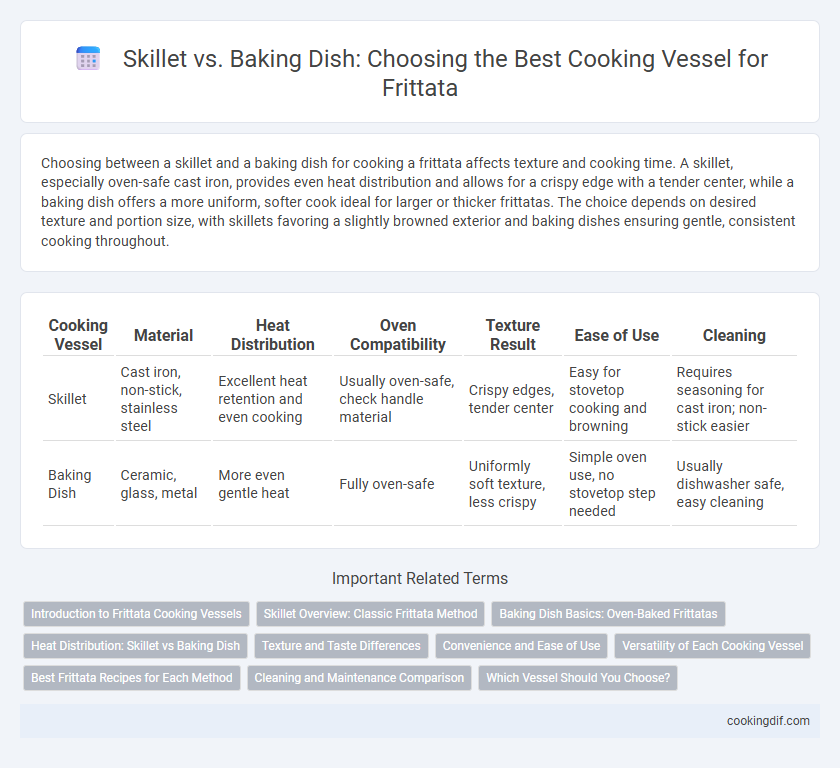Choosing between a skillet and a baking dish for cooking a frittata affects texture and cooking time. A skillet, especially oven-safe cast iron, provides even heat distribution and allows for a crispy edge with a tender center, while a baking dish offers a more uniform, softer cook ideal for larger or thicker frittatas. The choice depends on desired texture and portion size, with skillets favoring a slightly browned exterior and baking dishes ensuring gentle, consistent cooking throughout.
Table of Comparison
| Cooking Vessel | Material | Heat Distribution | Oven Compatibility | Texture Result | Ease of Use | Cleaning |
|---|---|---|---|---|---|---|
| Skillet | Cast iron, non-stick, stainless steel | Excellent heat retention and even cooking | Usually oven-safe, check handle material | Crispy edges, tender center | Easy for stovetop cooking and browning | Requires seasoning for cast iron; non-stick easier |
| Baking Dish | Ceramic, glass, metal | More even gentle heat | Fully oven-safe | Uniformly soft texture, less crispy | Simple oven use, no stovetop step needed | Usually dishwasher safe, easy cleaning |
Introduction to Frittata Cooking Vessels
Choosing between a skillet and a baking dish for cooking a frittata impacts texture and cooking time significantly. Skillets, especially oven-safe cast iron or nonstick pans, provide even heat distribution and allow for seamless stovetop-to-oven transitions, enhancing browning and crisp edges. Baking dishes, often ceramic or glass, offer gentle, consistent heat for a tender, evenly cooked frittata but may lack the direct heat advantages that skillets provide.
Skillet Overview: Classic Frittata Method
A cast-iron or non-stick skillet is the classic vessel for cooking a frittata, providing even heat distribution and excellent heat retention essential for the custard-like texture. The skillet allows seamless stovetop-to-oven transition, enabling the eggs to begin cooking gently on the burner before finishing under the broiler or in the oven to set the top. This method enhances browning and develops the signature golden crust while maintaining a creamy interior.
Baking Dish Basics: Oven-Baked Frittatas
Baking dishes provide even heat distribution essential for perfectly cooked oven-baked frittatas, ensuring a consistent texture and golden-brown top. Ceramic or glass baking dishes retain heat effectively, allowing the frittata to cook thoroughly without burning the edges. Using a baking dish also simplifies cleanup and offers a visually appealing presentation directly from oven to table.
Heat Distribution: Skillet vs Baking Dish
A cast-iron skillet offers superior heat retention and even heat distribution, ensuring the frittata cooks uniformly with a perfectly browned crust. In contrast, a baking dish, often made of ceramic or glass, provides more gradual and gentle heat, which helps the frittata cook slowly but can result in less crisp edges. Optimal heat distribution in the cooking vessel directly impacts texture and doneness, making skillet preferable for a crisp exterior and baking dish ideal for softer, custard-like results.
Texture and Taste Differences
Cooking a frittata in a skillet often results in a beautifully crispier edge and a slightly smoky flavor due to direct stovetop heat, enhancing the overall texture with a golden-brown crust. Using a baking dish tends to produce a more uniform, tender texture throughout, as the gentle, even oven heat cooks the eggs more gradually, preserving moisture and yielding a creamier taste. The choice between skillet and baking dish directly influences the balance between crispy exterior and soft interior, shaping the final sensory experience of the frittata.
Convenience and Ease of Use
A skillet offers superior convenience for cooking a frittata by allowing seamless stovetop to oven transition, enabling precise heat control and easy stirring during initial cooking. Baking dishes require transferring the partially cooked frittata, which may complicate handling and increase cleanup. Non-stick skillets simplify flipping and reduce the need for excessive oil, enhancing ease of use and overall cooking experience.
Versatility of Each Cooking Vessel
Skillets offer superior versatility for frittata preparation, enabling direct stovetop cooking for even heat distribution and seamless transition to the oven. Baking dishes provide ample space for larger frittatas and are ideal for slow, uniform baking but lack the stovetop functionality essential for initial egg setting. Choosing between a cast iron skillet and a ceramic or glass baking dish depends on desired texture, cooking control, and portion size flexibility in frittata recipes.
Best Frittata Recipes for Each Method
Skillet-cooked frittatas develop a rich, crispy edge and a tender, custardy interior, ideal for recipes featuring sauteed vegetables or breakfast meats. Baking dishes produce evenly cooked frittatas with a uniform texture, perfect for layered ingredients like cheese and herbs that require gentle heat distribution. For best results, cast iron skillets suit stovetop-to-oven recipes, while ceramic or glass baking dishes excel in oven-only preparations, ensuring optimal flavor and texture in every bite.
Cleaning and Maintenance Comparison
Skillets, especially non-stick or cast iron, offer easier cleaning due to their smooth surfaces and natural seasoning that prevents food from sticking, reducing residue buildup. Baking dishes, often ceramic or glass, may require soaking to remove baked-on egg residue and can be prone to staining or chipping over time. Regularly seasoning cast iron skillets enhances durability and cleaning efficiency, whereas baking dishes demand gentle handling to maintain surface integrity and prolong usability.
Which Vessel Should You Choose?
Choosing between a skillet and a baking dish for cooking a frittata depends on heat distribution and presentation preferences. Cast iron skillets provide even heat and a well-browned crust, ideal for stovetop-to-oven cooking, while baking dishes offer a gentle, uniform bake perfect for delicate, evenly cooked frittatas. Consider a cast iron skillet for a crispy texture and a baking dish for consistent softness throughout the frittata.
Skillet vs Baking Dish for frittata cooking vessel Infographic

 cookingdif.com
cookingdif.com